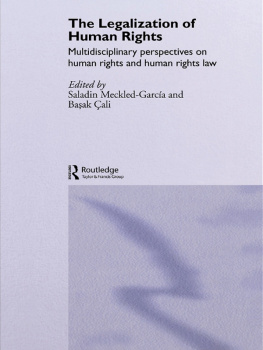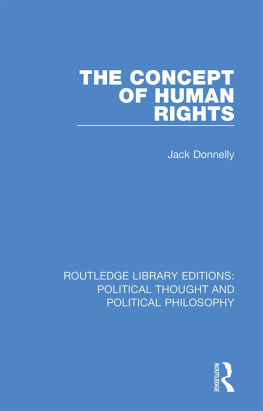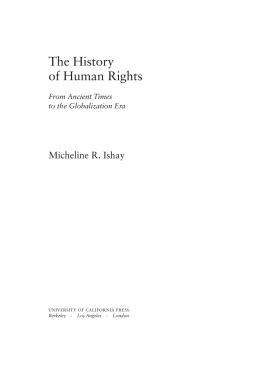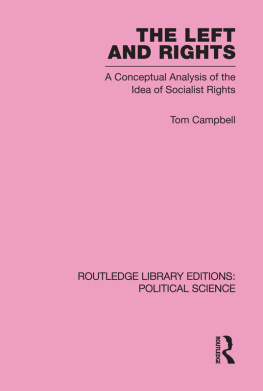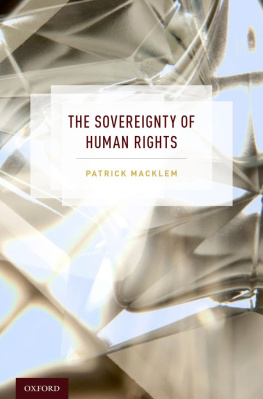THE ARCHITECTURE OF CONCEPTS
The Architecture of Concepts
THE HISTORICAL FORMATION OF HUMAN RIGHTS
PETER DE BOLLA
FORDHAM UNIVERSITY PRESS
New York 2013
Copyright 2013 Fordham University Press
All rights reserved. No part of this publication may be reproduced, stored in a retrieval system, or transmitted in any form or by any meanselectronic, mechanical, photocopy, recording, or any otherexcept for brief quotations in printed reviews, without the prior permission of the publisher.
Fordham University Press has no responsibility for the persistence or accuracy of URLs for external or third-party Internet websites referred to in this publication and does not guarantee that any content on such websites is, or will remain, accurate or appropriate.
Fordham University Press also publishes its books in a variety of electronic formats. Some content that appears in print may not be available in electronic books.
Library of Congress Cataloging-in-Publication Data
De Bolla, Peter, 1957
The architecture of concepts : the historical formation of human rights / Peter de Bolla.
pages cm
Summary: The Architecture of Concepts presents a new history of ideas. Using digital archives to track the historical formation of the concept of human rights across the Anglophone eighteenth century, it argues that a better understanding of the architecture of the concept will enable us to deliver on its universal aspirations Provided by publisher.
Includes bibliographical references and index.
ISBN 978-0-8232-5438-5 (hardback) ISBN 978-0-8232-5439-2 (paper)
1. Human rightsHistory. 2. Civil rightsHistory. 3. Liberty. I. Title.
JC571.D3328 2013
323dc23
2013021233
Printed in the United States of America
15 14 13 5 4 3 2 1
First edition
In memoriam
Gregory T. Polletta
CONTENTS
ACKNOWLEDGMENTS
This book has been made possible by the Leverhulme Foundation. Without the award of a Major Research Fellowship (20072010), the tooling up required to carry out this project would have been impossible. I am grateful to the director of the Leverhulme and its awards committee for providing the grant that gave me the unencumbered time that any major research project needs. I am also grateful to the University of Cambridge for accepting the terms of the award, something that increasingly one may not be able to take for granted. My faculty colleagues and the University committee overseeing leave entitlement also provided the opportunity for completing the manuscript by granting additional leave in 20112012.
Many friends, colleagues, and members of a large number of audiences helped me shape and refine the project. It gives me enormous pleasure to thank the following who were instrumental in providing occasions on which I had the opportunity to present my ideas in public: Amanda Anderson, John Barrell, John Bender, Jay Clayton, Maud Ellmann, Frances Ferguson, Harriet Guest, Ewan Jones, Jonathan Lamb, James Raven, Bruce Robbins, David Simpson, Cliff Siskin, and John Wilkinson.
The years spent on this project have almost precisely overlapped with my participation in the Re:Enlightenment Project, directed by Cliff Siskin at NYU. My colleagues in that project, William St Clair, Leslie Santee Siskin, Kim Sloan, and Bill Warner, have been exposed to the development of my thinking about concepts more than they might have wished. I thank them for providing excellent company and invigorating discussion. I would particularly like to acknowledge the importance of a three-way collaborative venture within the Re:Enlightenment group for testing some of the most challenging ideas presented in this book. Thanks to Cliff Siskin and Bill Warner for engaging in a truly collective enterprise.
Books are written in lived contexts. It would be fraudulent not to acknowledge the very privileged environment in which I have been lucky enough to carry out my professional life. The peculiar and often peculiarly absorbing environment of collegiate Cambridge has both generated the intellectual milieu I consider to be my home and at the same time given definition to what I have from time to time needed to escape. But whether at home or abroad, my intellectual companions have been constantly in the background as the project took shape. This book has not been written for them, but they have been my imagined interlocutors on many more occasions than they might care to know.
The pleasures and accidents of daily life also provide the backdrop for any research project, and they have had more of a determining effect on both its progress and shape than I am able to fully know. In this case, the lived context within which this book has been written has just one companion. It has not been written for her, but it has been my great good luck to count on her companionship throughout its writing.
It is a great sadness to me that another companion, the person who read the penultimate draft of this book with extraordinary care and generosity, did not live to see it in print. It is dedicated to his memory.
Shepreth, November 2012
Introduction
This book has three distinct aims. First, it seeks to contribute to our understanding of concepts. Such a contribution is doubtless fraught with difficulty since even a cursory inspection of the very wide range of disciplines and even more disparate discursive locales in which the word concept is used leads to the conclusion that we do not seem to have a very clear sense of what concepts are, or might be. Once one begins, say, to compare how literary or social studies work with the term, or attempts to find a common thread in how philosophy, across its various subdisciplines and areas of inquiry, deploys the word, it rapidly becomes clear that we are a very long way away from something like a generaland certainly generally acceptedtheory of concepts. For many, this would seem to cause few problems. Concept, like its close cognates idea or notion, appears to do the work we ask of it while remaining poorly delineated conceptually. But if one is interested in the history of ideas, of how we come to think of certain things the way we do, where things refers not to concrete objects but to abstractions, a theory of concepts, or at least a more detailed account of how concepts are formed and operate over time and how they function in particular local instances of thinking, would be useful. Although in its most general formulation the question Where do ideas come from? is unlikely to generate much excitement, the more specific question Where does the idea of universal human rights come from? seems worth asking. And in its wake some follow up questions, How did such an idea get credence?, What ideas are associated with or distinguished from it?, Have such associations or differentiations been the same over time? also seem worthwhile. While the following study does not propose a general theory of concepts, it does suggest ways in which the questions I have just raised might be answered with clarity and detail. More specifically, it offers a particular way of understanding the history of ideas that is sensitive to how concepts are structured and operate in historically determined networks of linked conceptual forms. That internal structurecall it the disposition of its elementscoupled to its connections within and across networks of associated and differentiated concepts is what I call the architecture of a concept. The books first aim, then, is to provide a more detailed and supple account of concepts as historical forms than is currently available.
Its second aim is to provide an exemplification of a specific methodology for tracking both the history of conceptual forms and their architectures by using data derived from digital archives. It is my hope that scholars will take this methodology, no doubt refining it along the way, and apply it to different conceptual examples. Since the history and shape of conceptual forms may have relevance for many researchers whose interest and expertise does not lie exclusively in the Anglophone eighteenth century or the history of ideas, I hope that the uses to which I put digital archives will provoke new kinds of inquiry in a wide range of disciplines.
Next page


